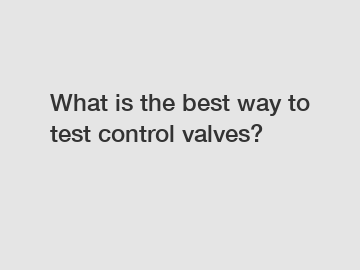Feb. 09, 2024
Tools
You will get efficient and thoughtful service from SUNCENTER.
What is the best way to test control valves?
Control valves play a crucial role in regulating the flow of fluids, gases, or steam in various industrial processes. Ensuring their optimal performance is essential for maintaining efficient and safe operations. Testing control valves is a critical aspect of their maintenance and troubleshooting. This article explores different methods to test control valves, highlighting their advantages, disadvantages, and suitable applications.

1. Bench Testing:
Bench testing involves removing the control valve from the process and testing it in a controlled environment. This method allows for detailed analysis and accurate measurements. It is typically performed in a workshop or laboratory with advanced equipment to simulate real operating conditions. Bench testing is beneficial when precise performance evaluation and diagnostic testing are required. However, it can be time-consuming and may not reflect the valve's actual performance in the process environment.
2. Online Testing:
Online testing refers to evaluating control valve performance while it is operating within the process system. This method allows for real-time assessment without interrupting the production process. Online testing can be conducted using various tools, such as valve signature analyzers, positioners, and smart positioners. It provides valuable information about the valve's response, stability, and control range under actual working conditions. However, online testing may require additional instrumentation and expertise, and it may not be suitable for all process situations.
3. Leak Testing:
Leakage is a common issue encountered in control valves. Leaks can lead to inefficiencies, product loss, safety hazards, and environmental concerns. Leak testing is crucial to identify and rectify any leakage problems. Various techniques can be employed, including visual inspection, acoustic monitoring, pressure testing, and bubble testing. The specific method chosen depends on the valve type, its operating conditions, and the level of leakage sensitivity required. Leak testing should be performed periodically as part of routine maintenance to ensure the valve's integrity.
4. Calibration:
Calibration is the process of adjusting the control valve to maintain accurate and precise control over the fluid flow. Over time, valves can drift from their initial calibration settings, resulting in inaccurate control. Calibration involves comparing the valve's response to known reference signals and adjusting it accordingly. Calibrating control valves can be done manually or using sophisticated calibration devices. Properly calibrated control valves enhance process efficiency, accuracy, and stability. Regular calibration is essential for long-term reliability and smooth operations.
5. Diagnostic Testing:
Diagnostic testing focuses on identifying any underlying issues or abnormalities in control valve performance. It involves analyzing various parameters, including pressure drop, flow rate, valve position, and response time. This testing aims to detect problems such as blockages, damaged components, improperly set parameters, or incorrect valve sizing. Diagnostic testing can be conducted during regular maintenance or when the valve's performance deviates from expected parameters. By addressing identified issues promptly, potential failures and costly downtime can be avoided.
In conclusion, testing control valves is crucial for ensuring their optimal performance in industrial processes. Bench testing provides precise measurements and diagnostic capabilities, while online testing offers real-time assessment without process interruption. Leak testing helps identify and rectify leakage issues, while calibration ensures accurate flow control. Diagnostic testing identifies any abnormalities and aids in preventative maintenance. Each testing method has its advantages and disadvantages, and the choice depends on the specific requirements and circumstances. Implementing a comprehensive testing regime and adhering to regular maintenance schedules are key to maximizing control valve efficiency, safety, and reliability.
For more high pressure nitrogeninformation, please contact us. We will provide professional answers.
If you are interested in sending in a Guest Blogger Submission,welcome to write for us!
All Comments ( 0 )